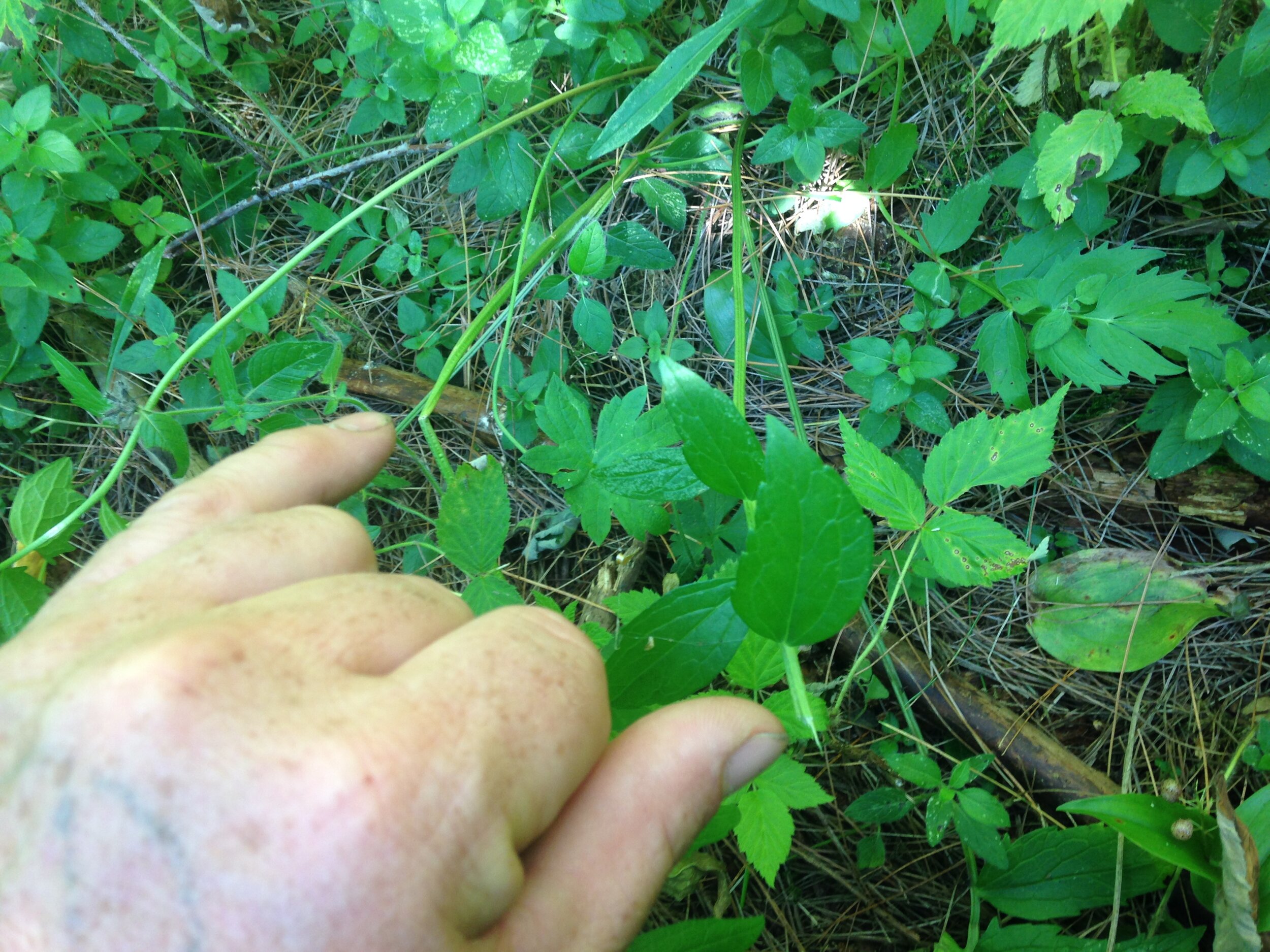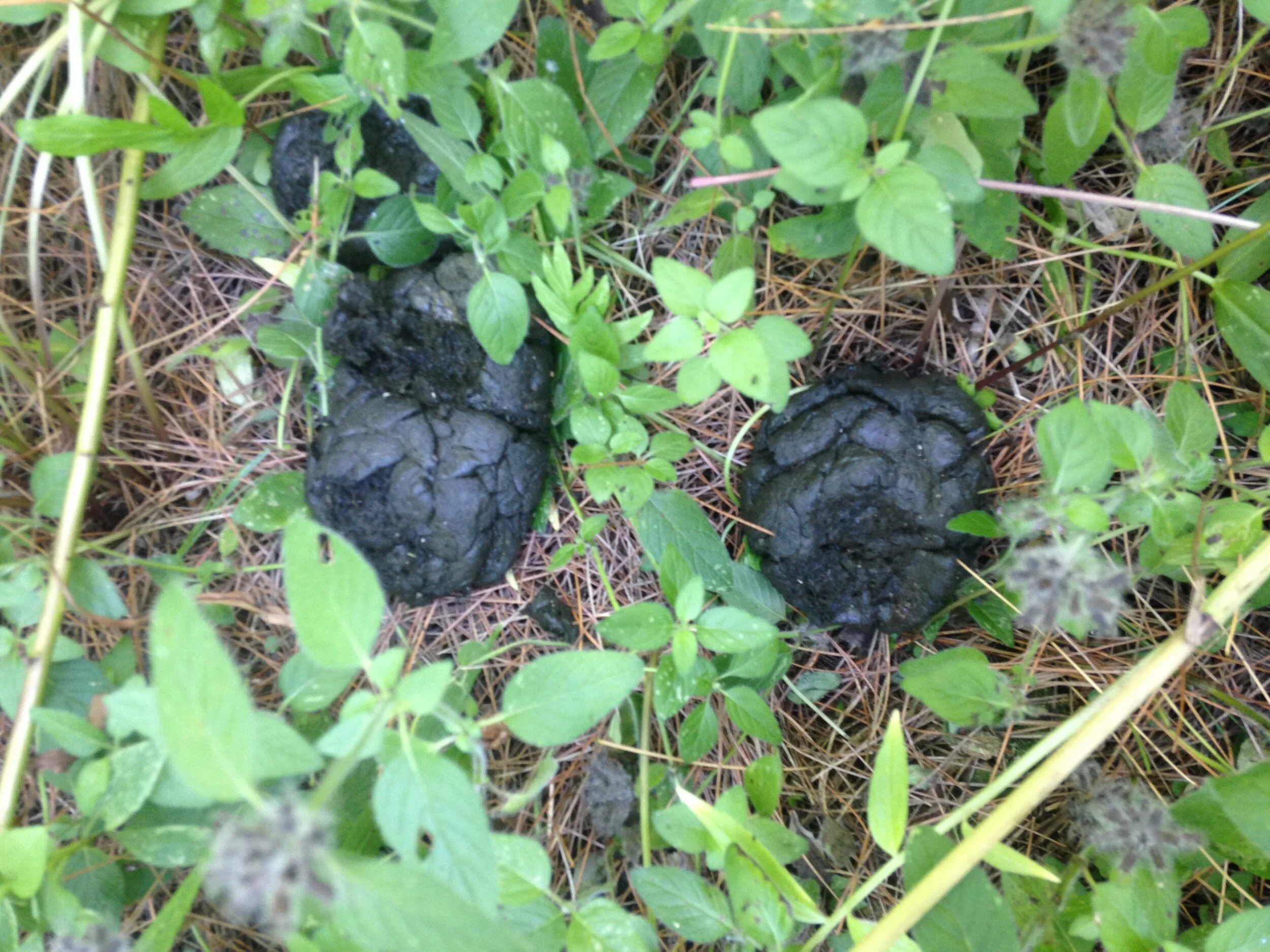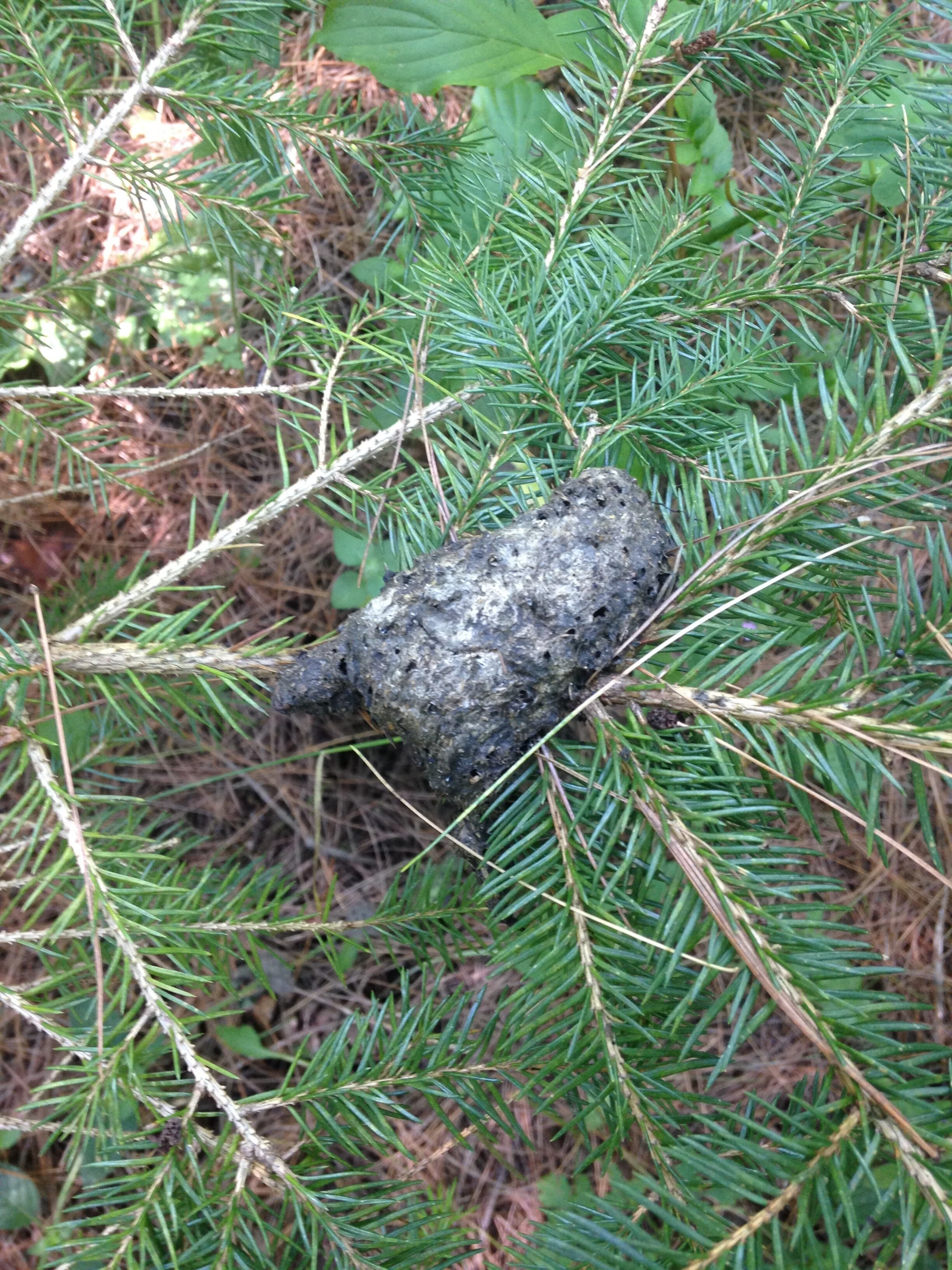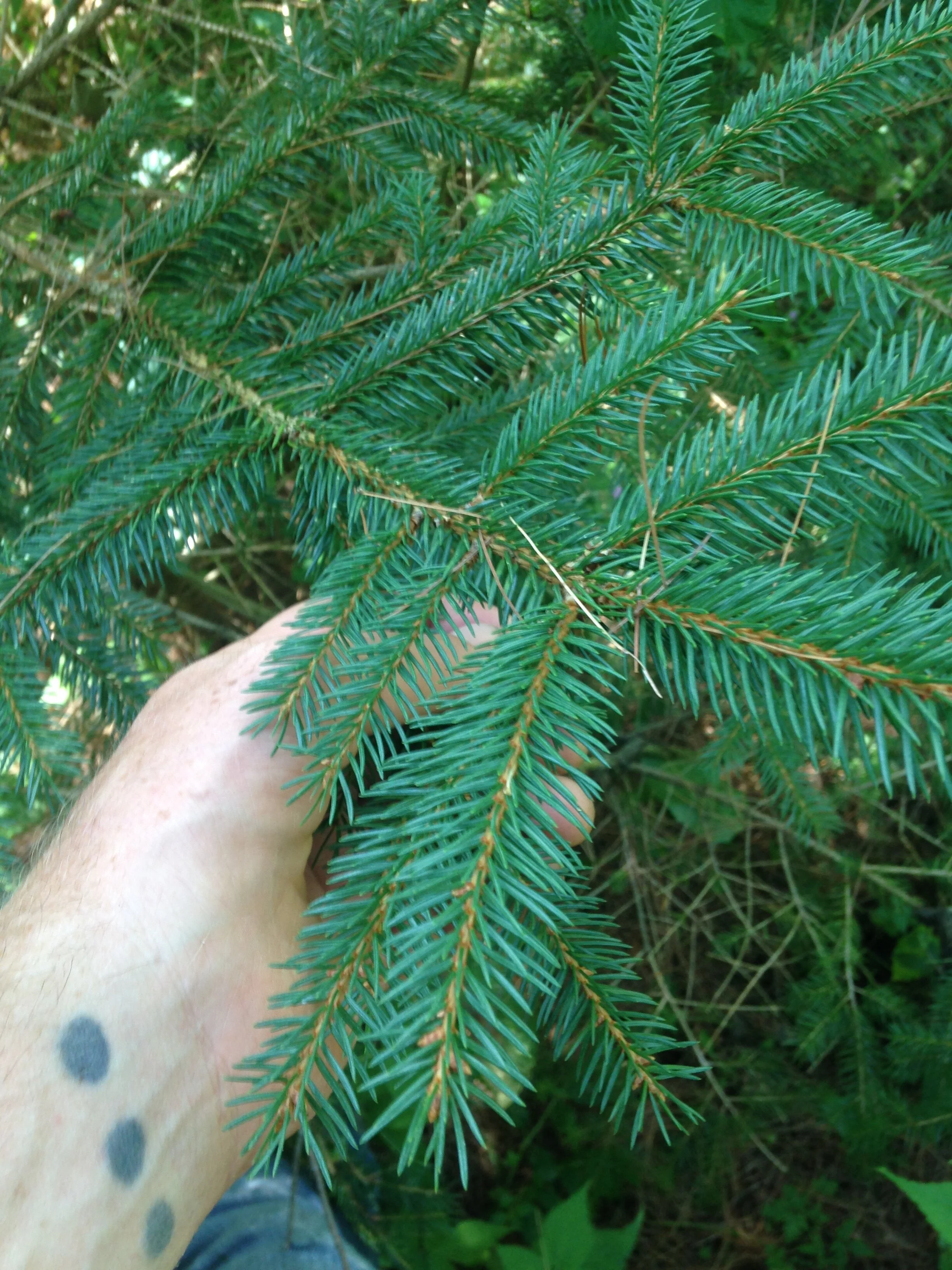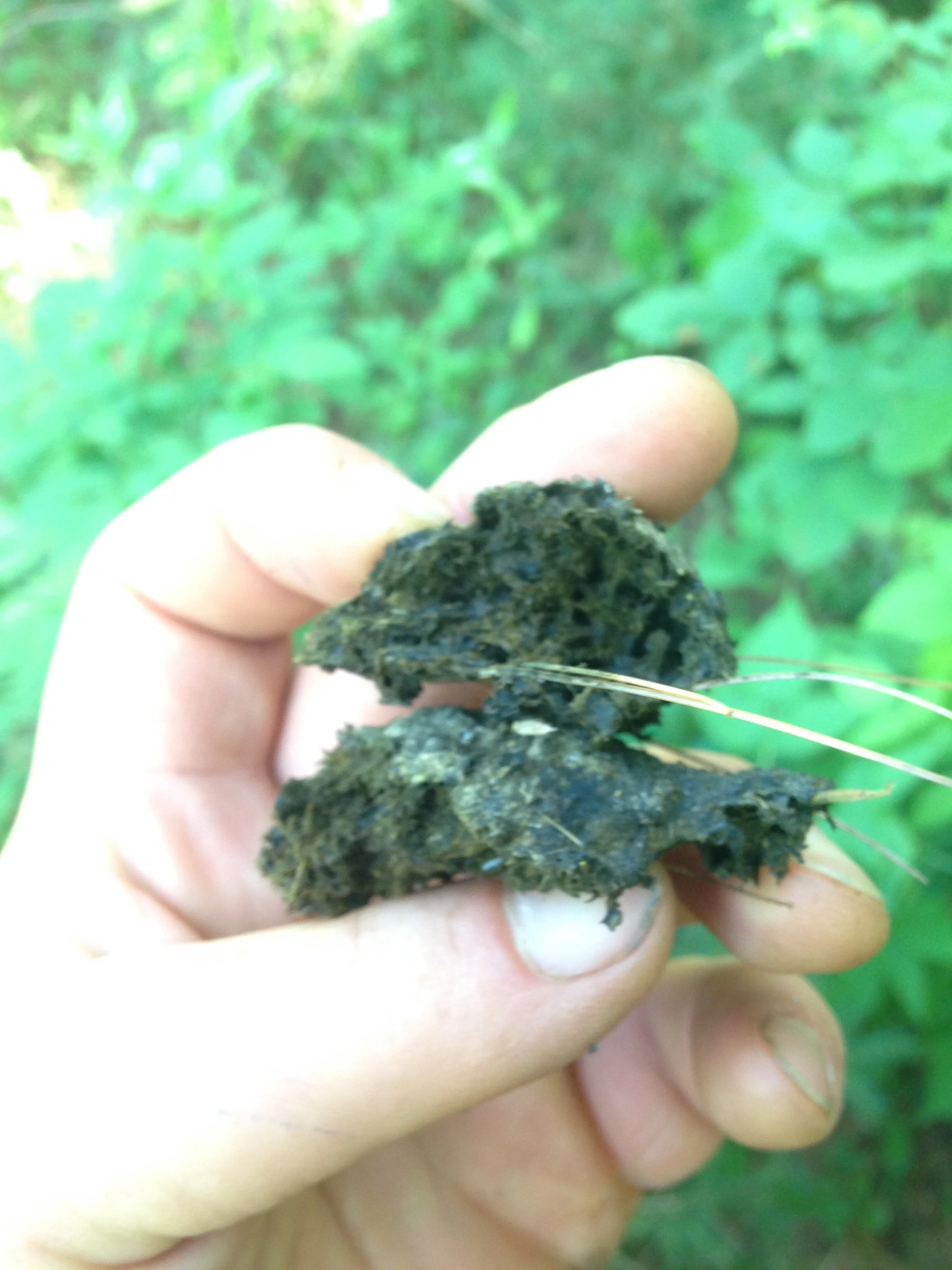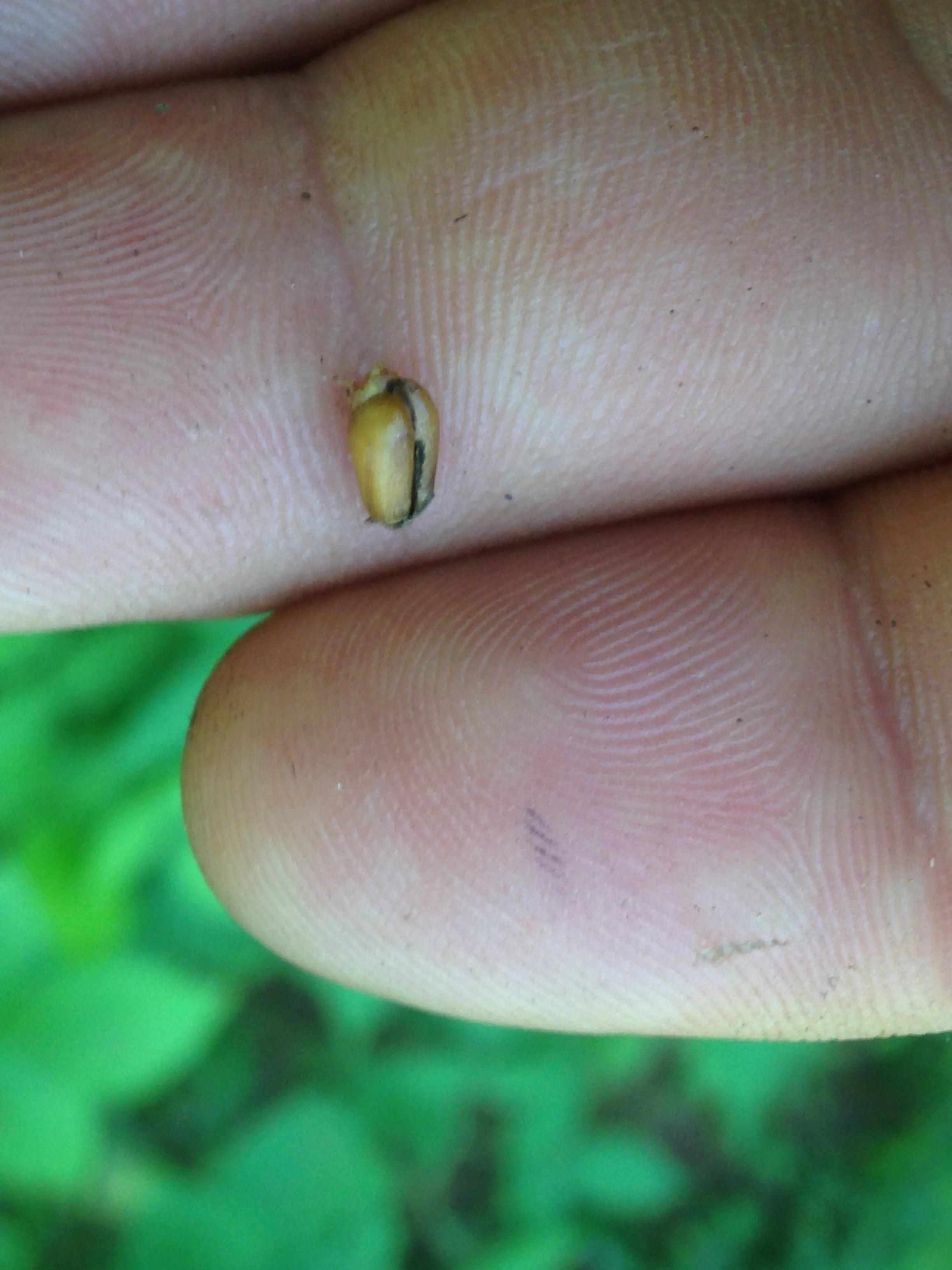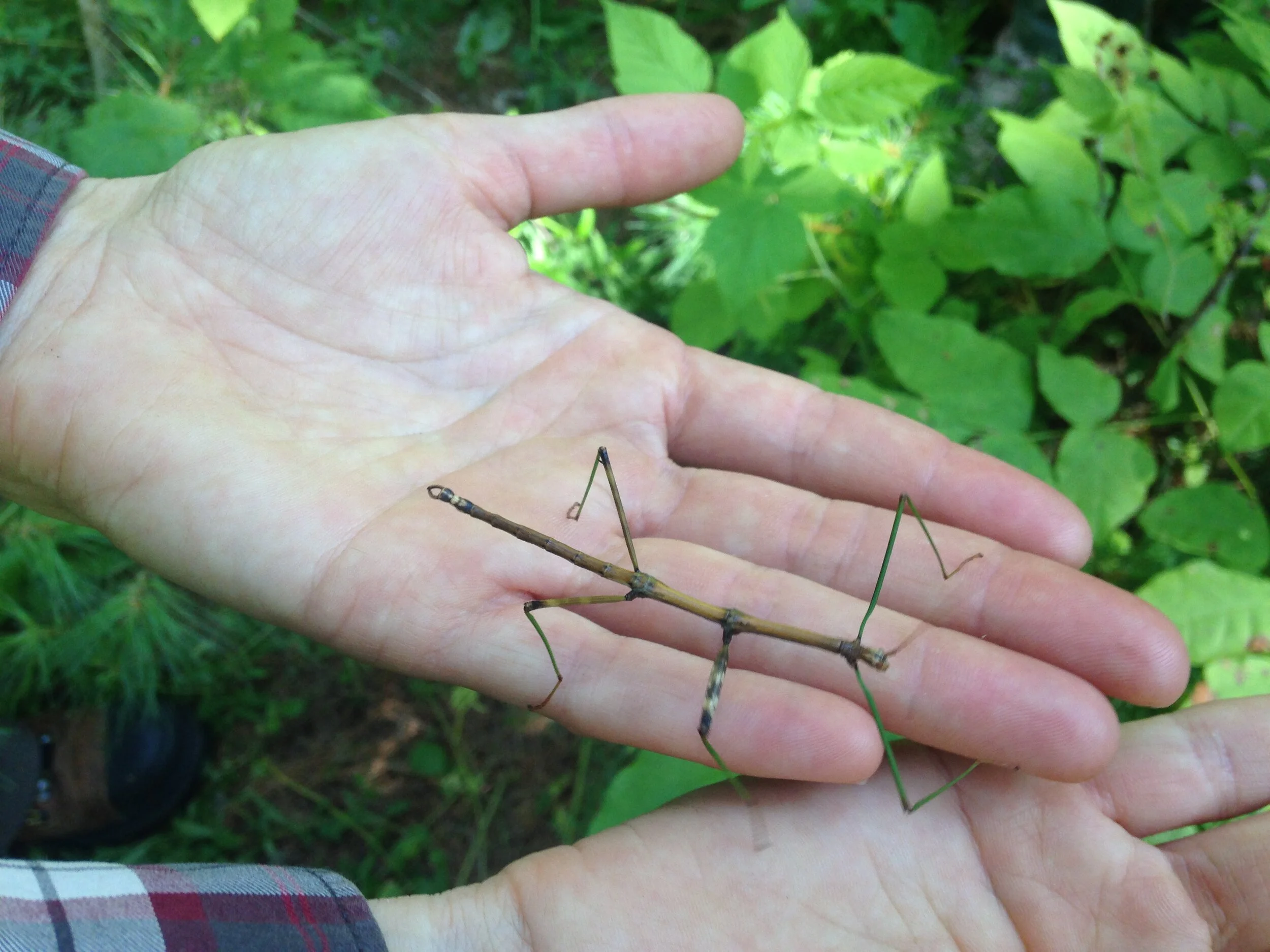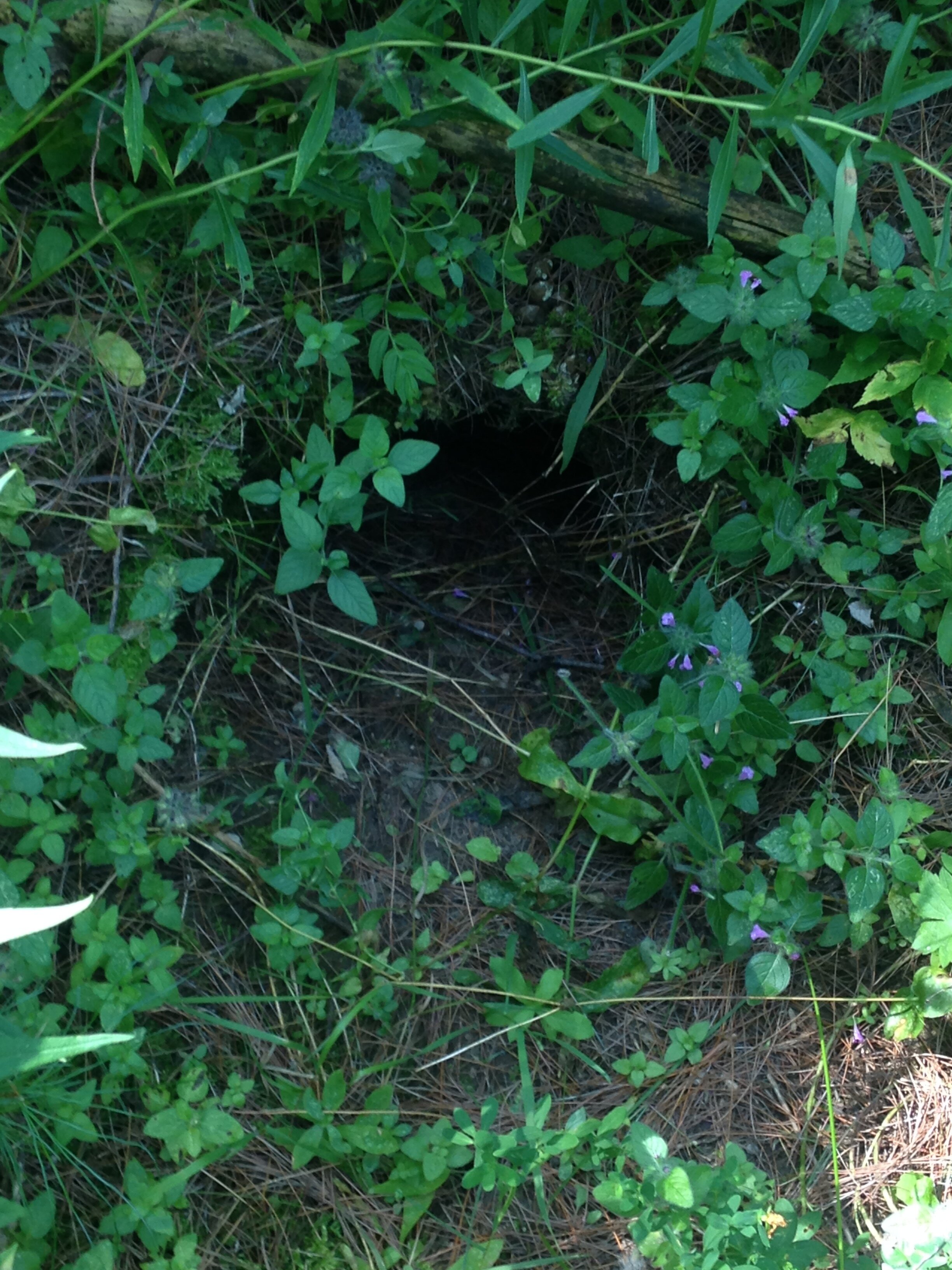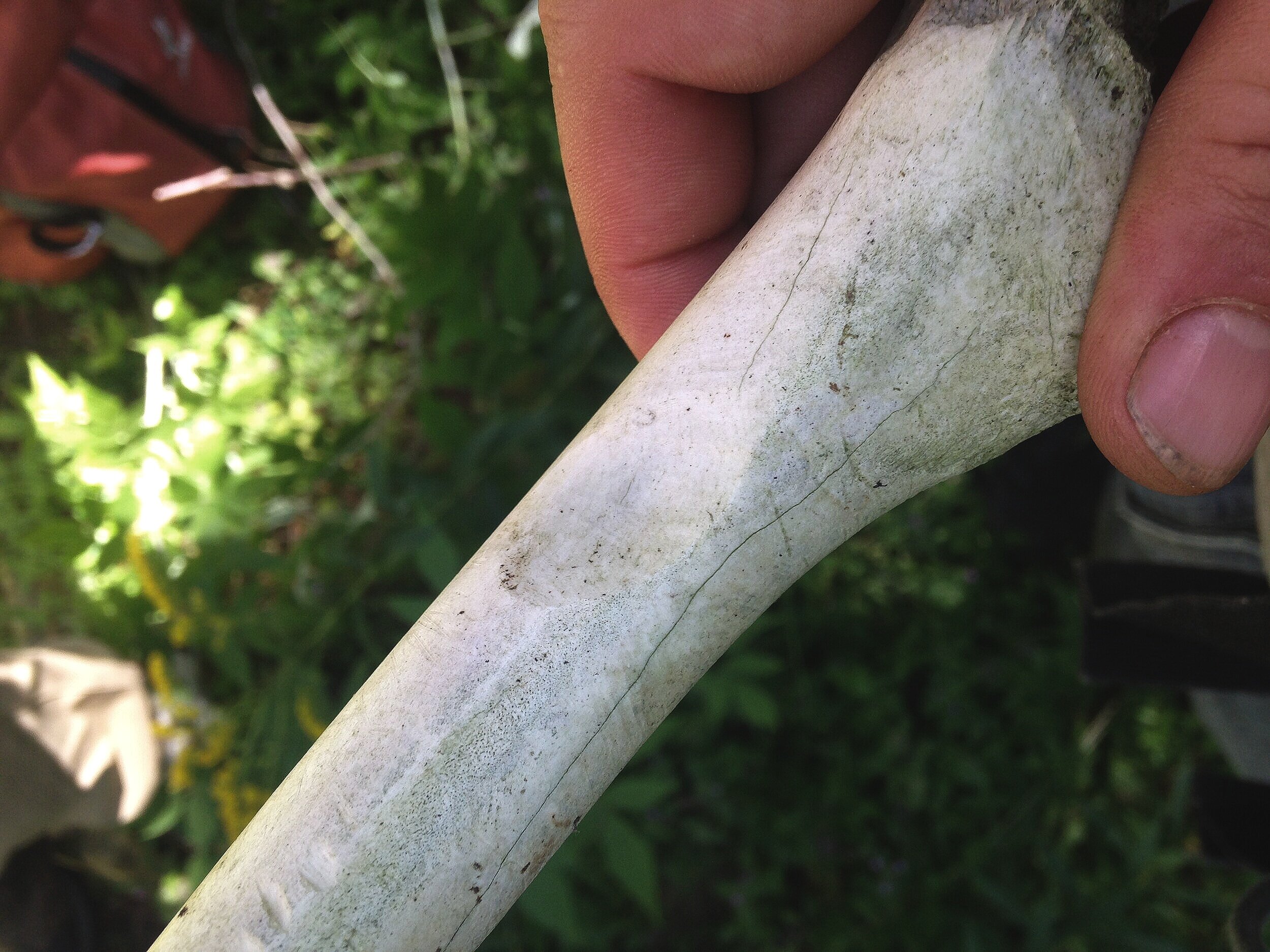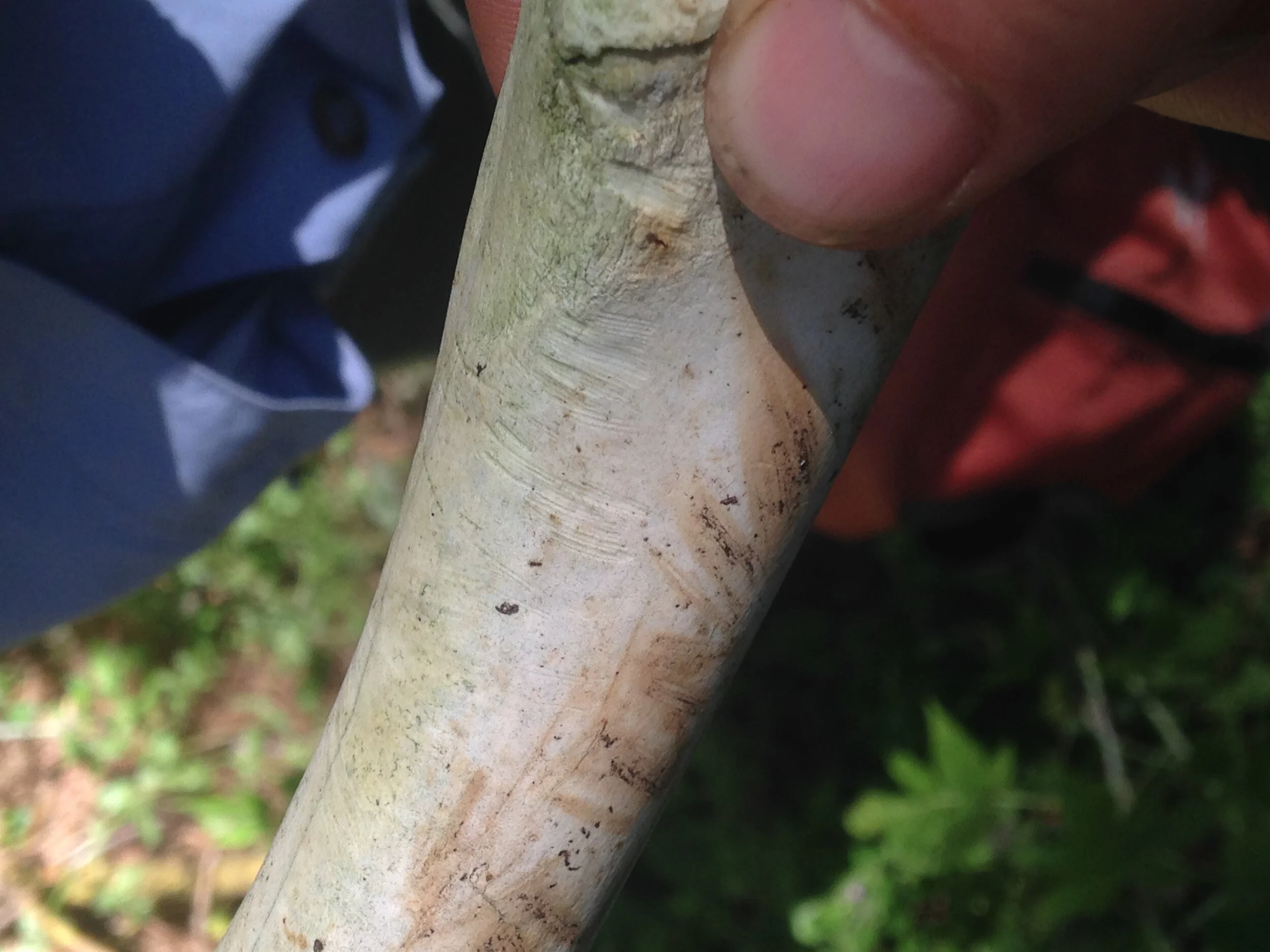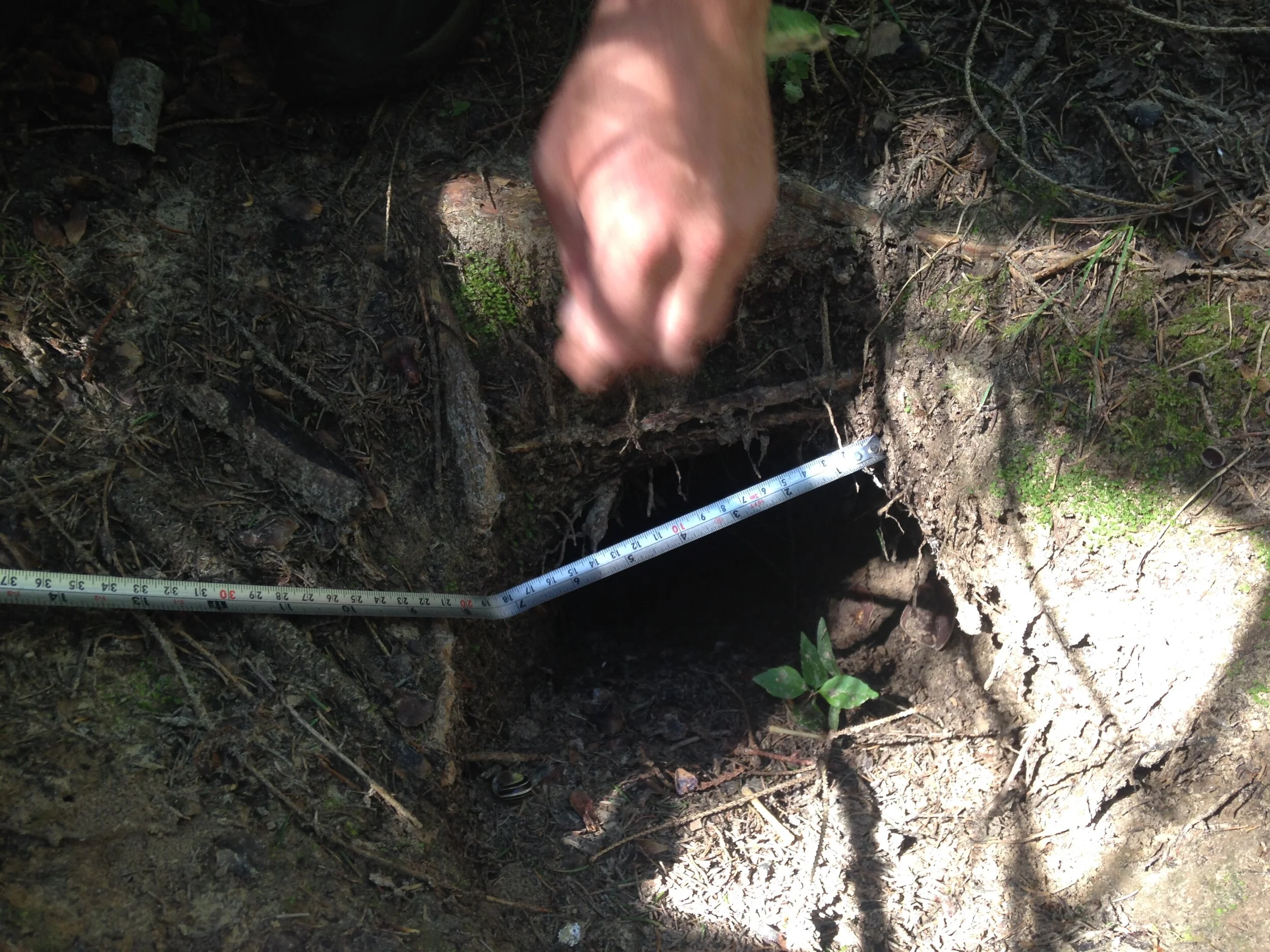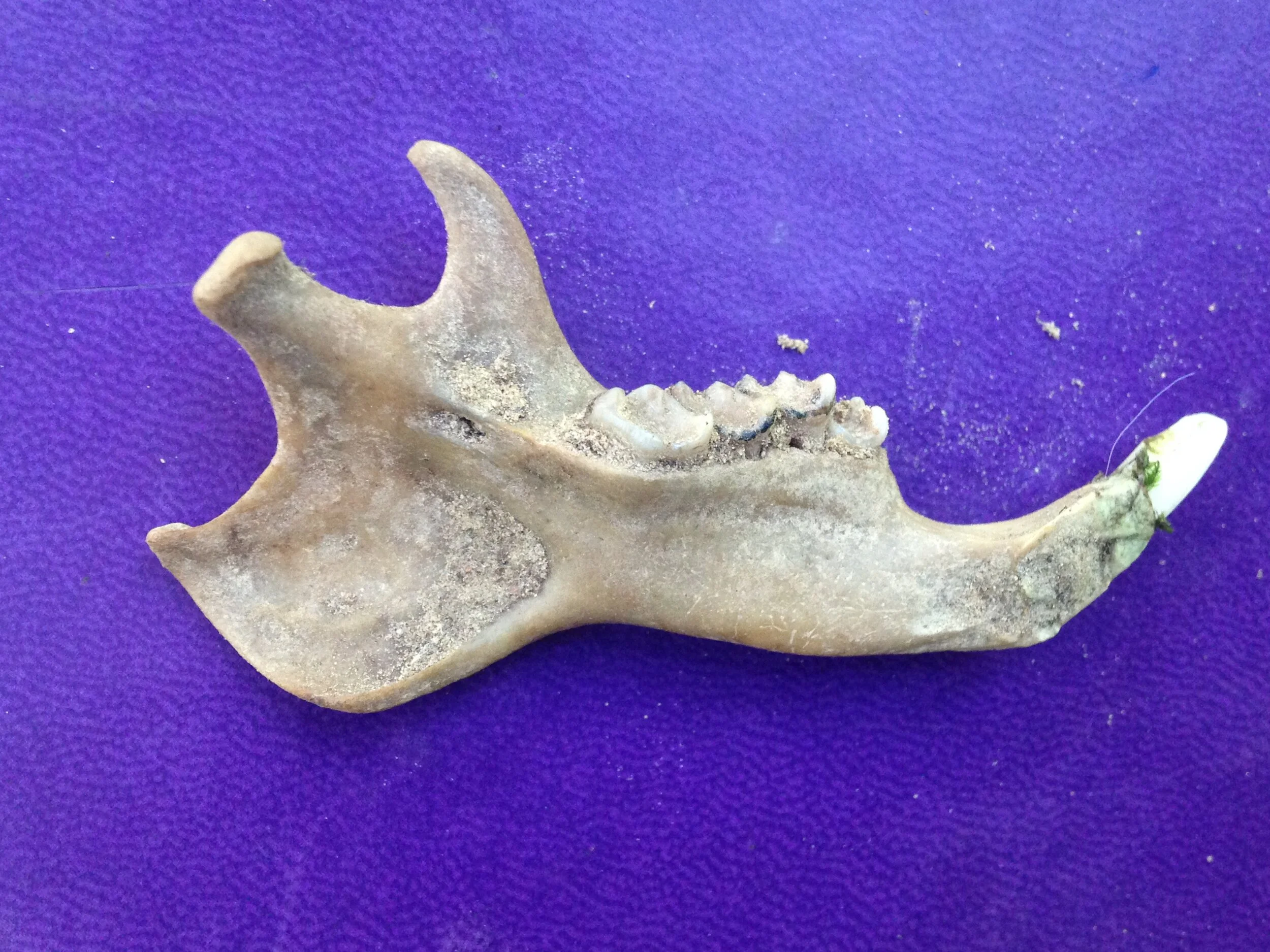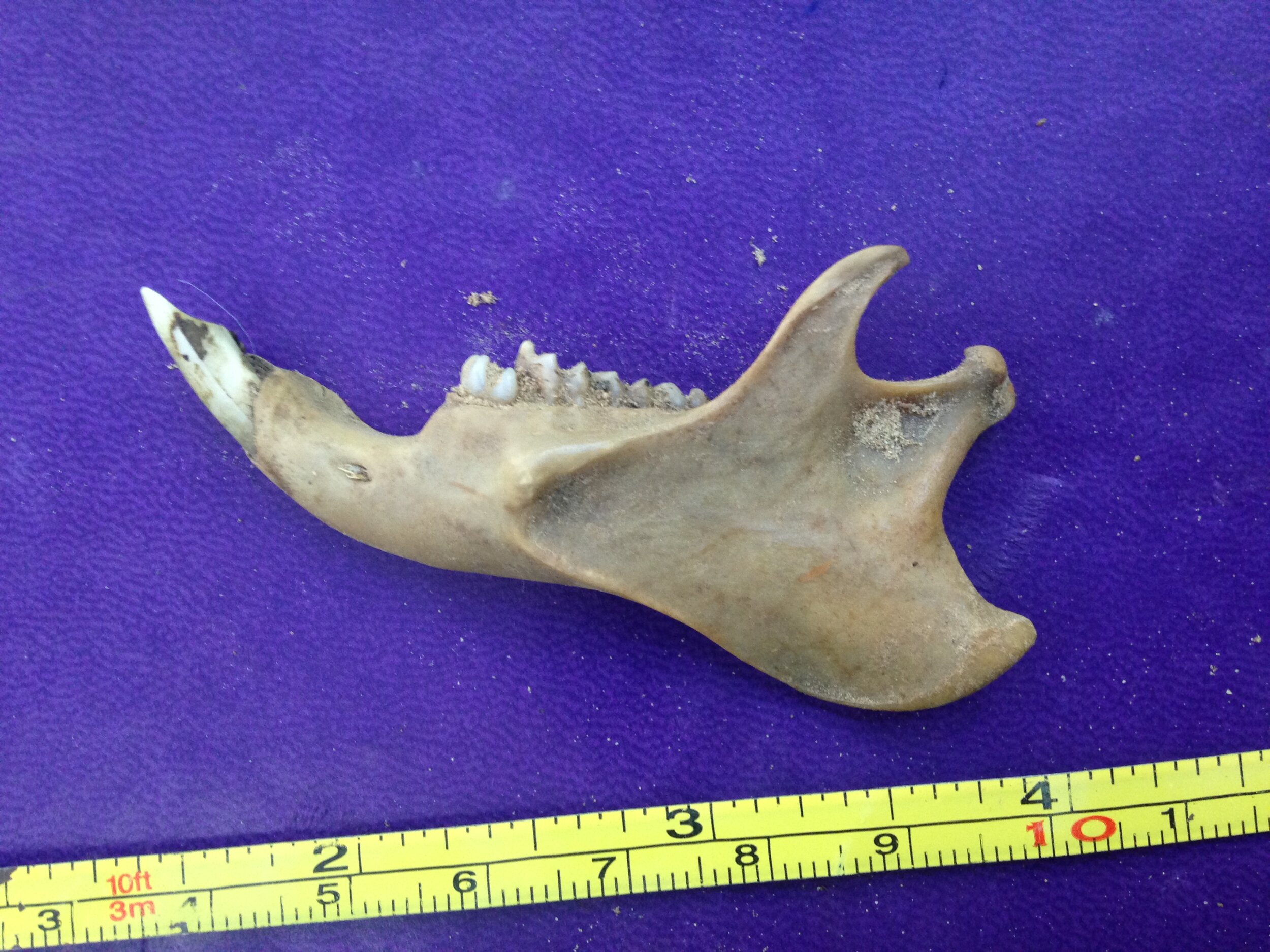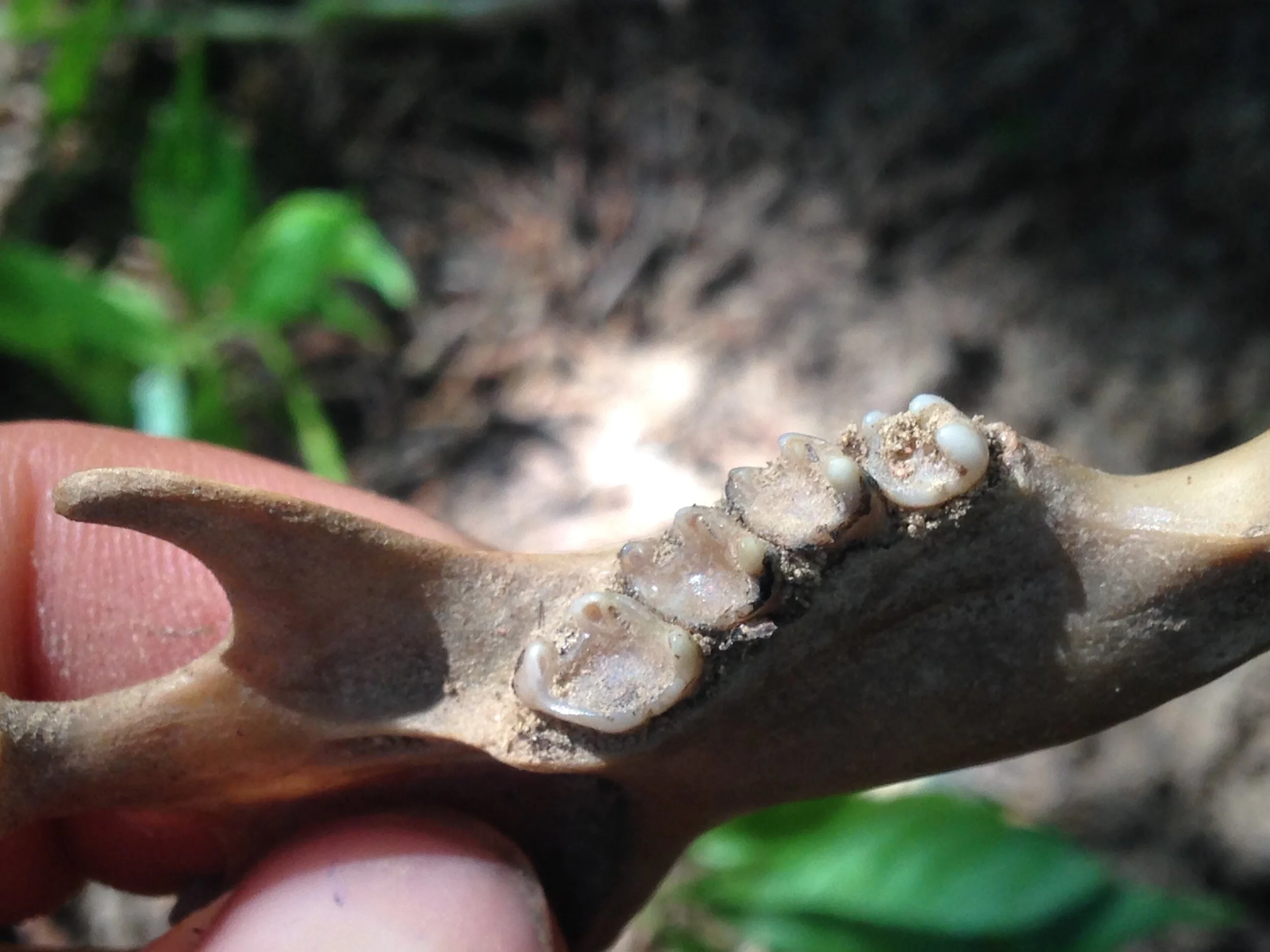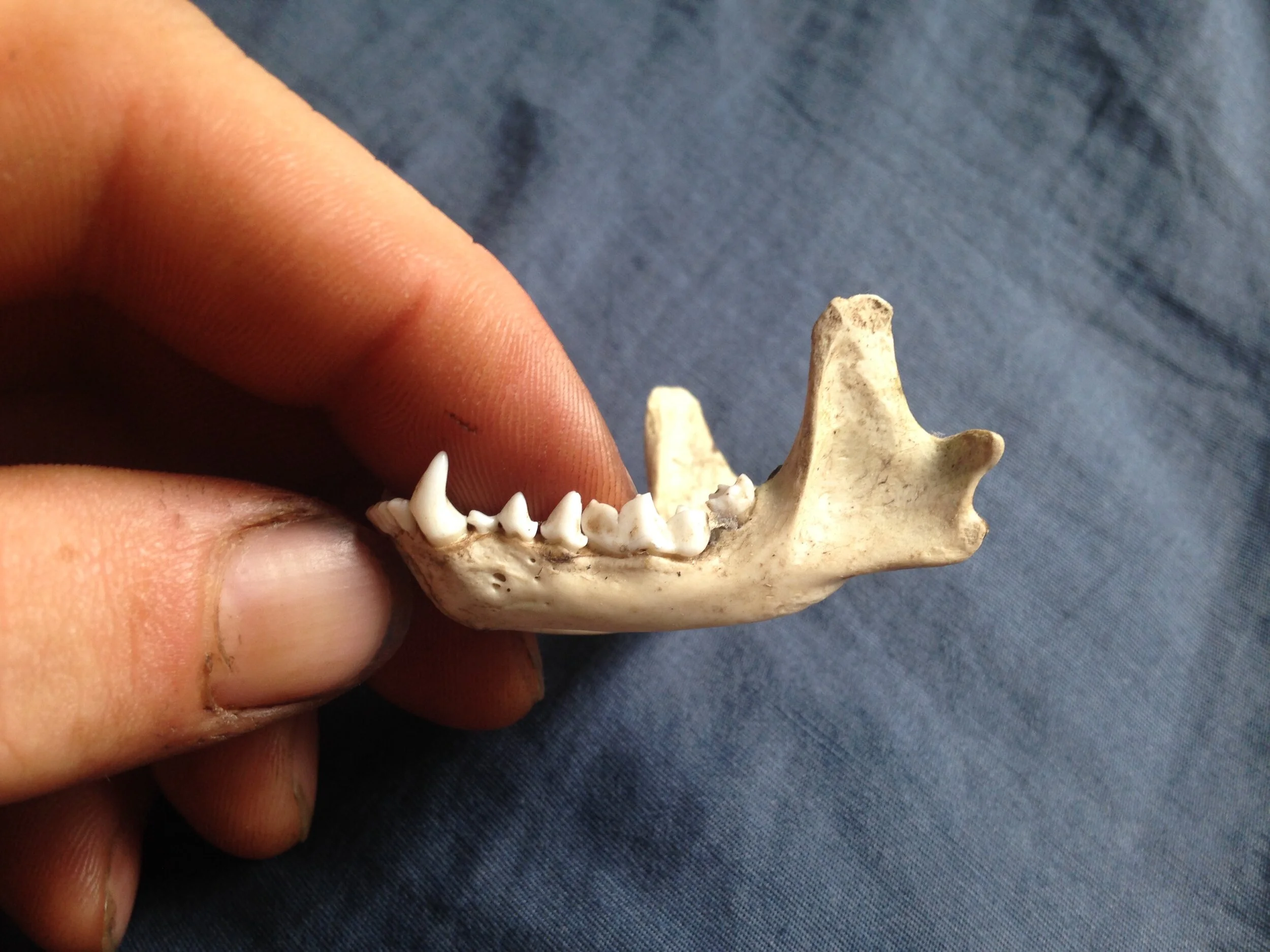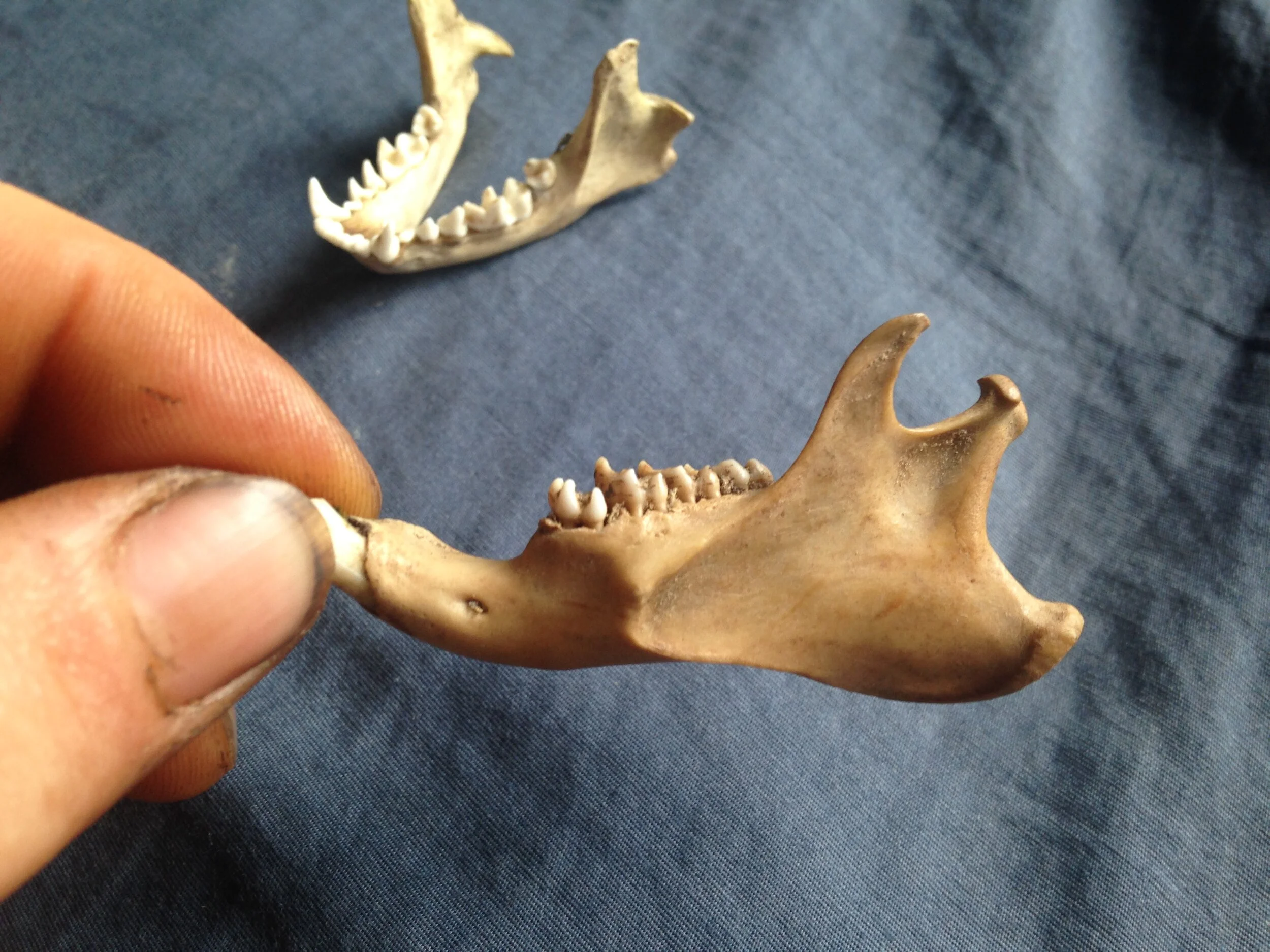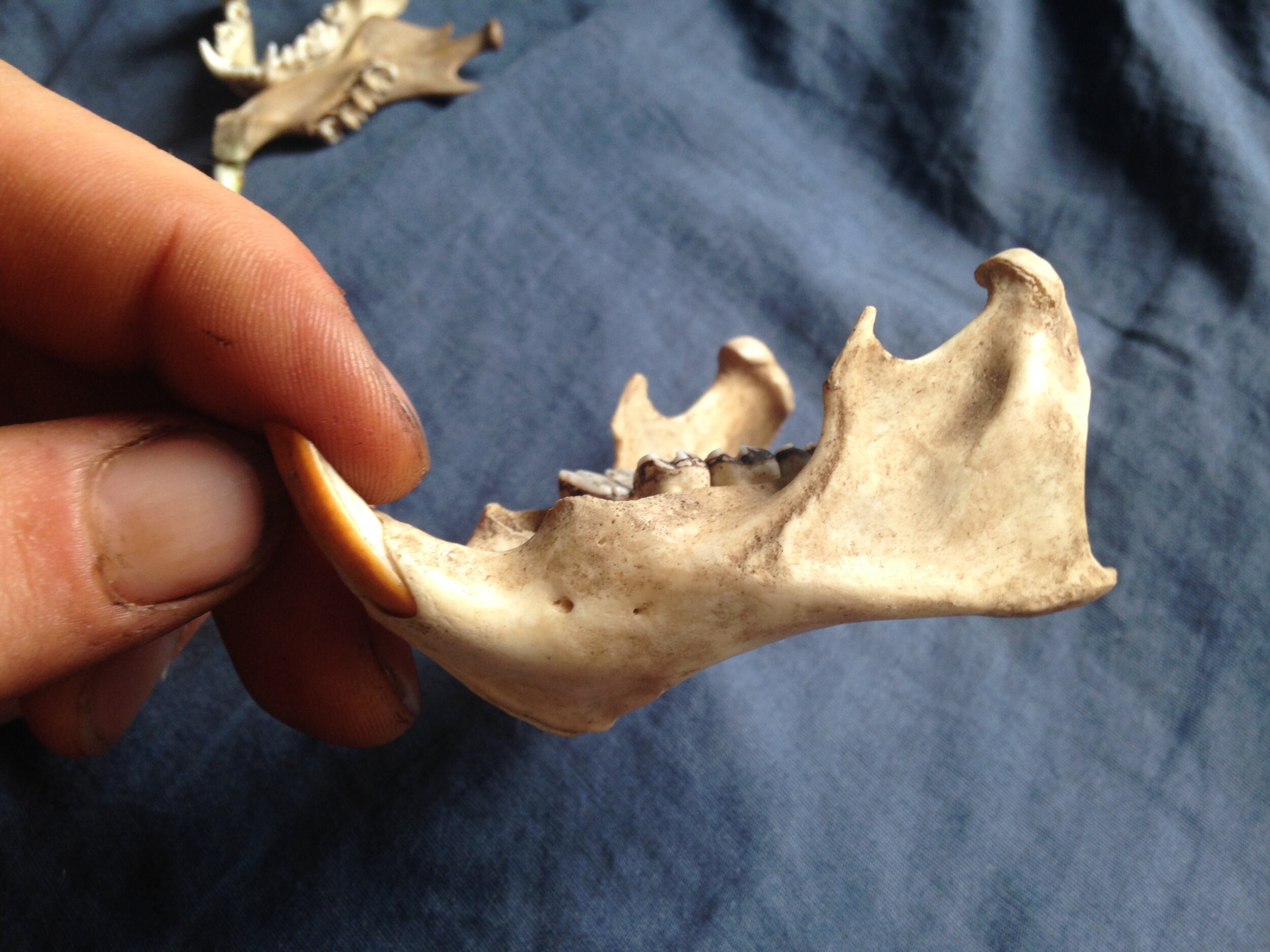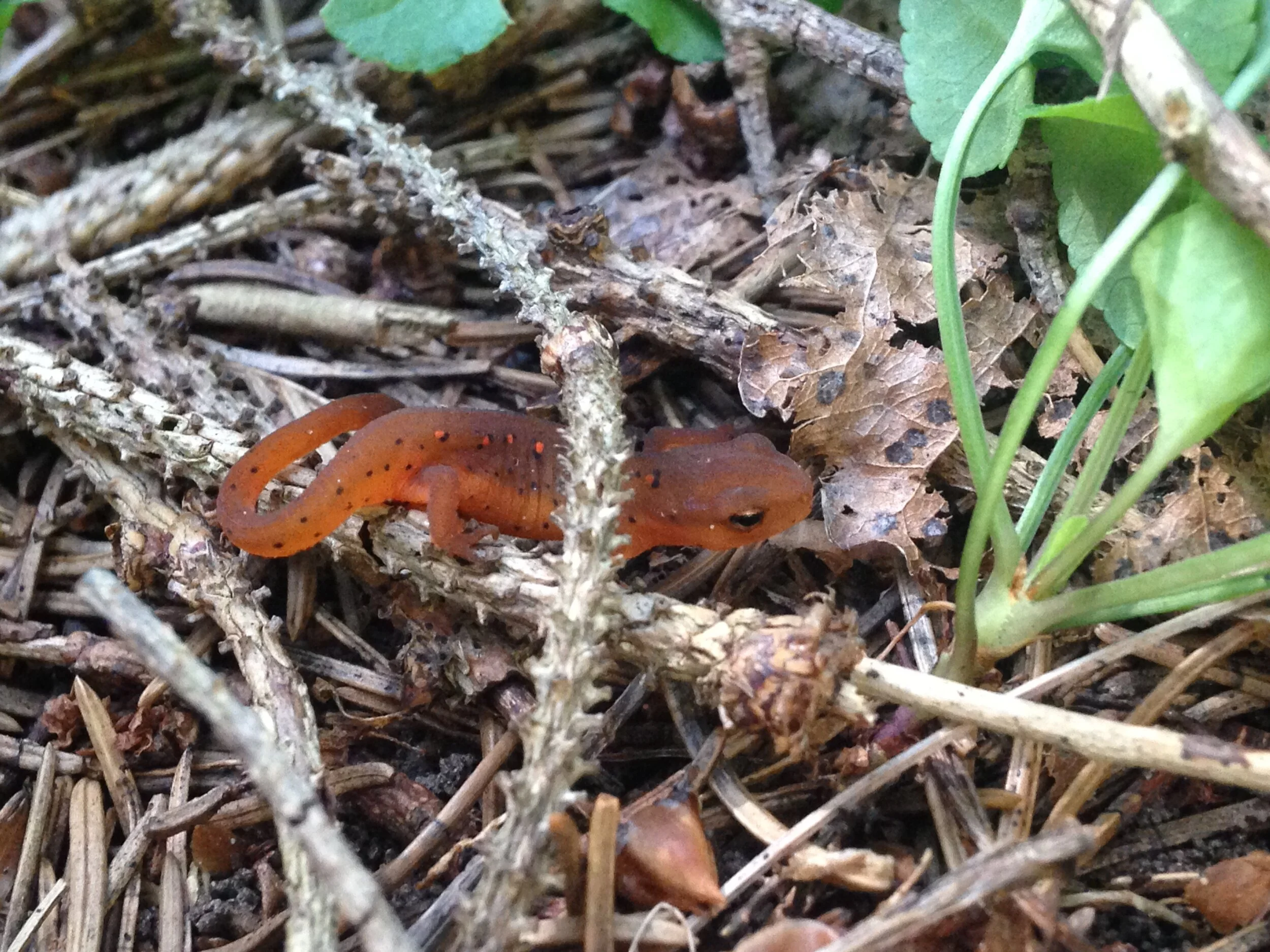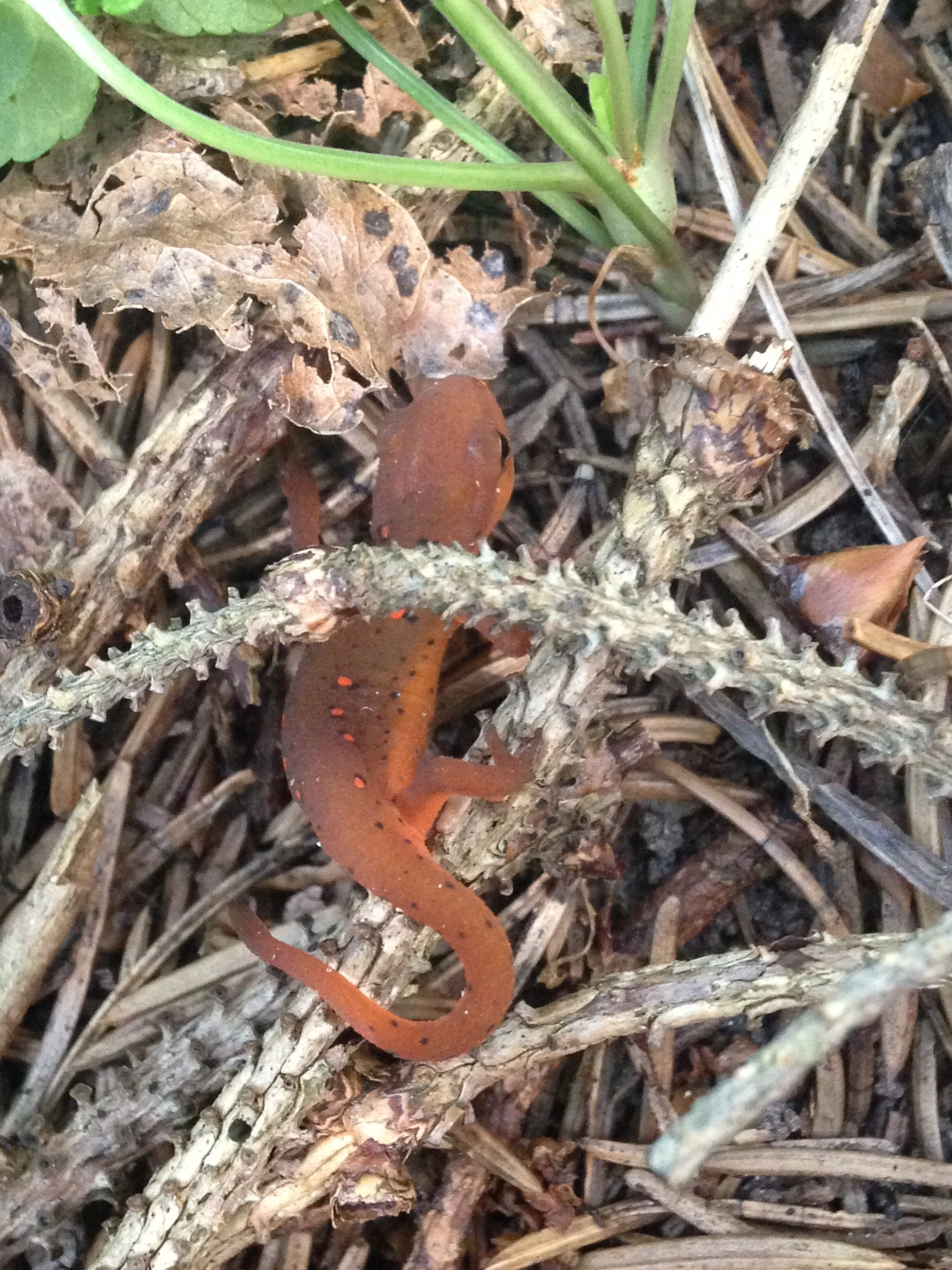Tracking Journal for 2021.08.15
We’d spent the most part of the day before and the morning of the 15th working in the tracking sandbox going over pressure releases. Pressure Releases are sign written within or without the track of an animal created by pressure against the substrate the animal has moved over. It is an indepth examination of the tracks looking beyond the identification of the animal and instead looking in the track for depth of motion and meaning. I previously wrote a more detailed post on pressure releases which you can read here. While working in the tracking sandbox there had been some live sightings of a rather ubiquitous, but ever interesting creature; One who would emerge from a small hole in the lawn about 3 m from the box, disappear into the underbrush, and then reappear later, bounding back through the grass back to their burrow where they would seemingly dive right in.
This hole measured about 4.3 cm (1.69”) and when I went to measure I noticed a more flattened dustier side where the small semi-fossorial mammal had emerged from. I crept a little less than 50 cm (19.69”) away and laid flat on my belly and watched the hole. There was a lot going on behind me, folks checking out the tracking box looking at their own tracks and seeing if they could see their stride and movements reflected in the compressions in the sand, but I kept my patience in hopes to see the creatures up close. And you know, as most sit spots or or quiet moments do, it paid off to watch and wait.
It didn’t take long for a small brown head to emerge from the hole, cautious and low, presumably listening and waiting themselves for any signs of alarm or caution in the topside environment. The head finally came up over the brown newly cut grass tips, and I looked into the deep dark eyes searching the world around them. I noticed the ears were so much larger than I had imagined before, and the face, stretched and longer than I had noticed in the past. I watched the nose working quickly taking in and deciphering smells, probably smelling the sweat on all of us humans working in the tracking box along with the aromatic Apples (Malus domesticus) ripening on the nearby trees. They might have even smelled the Chicken (Gallus gallus domesticus) feed put out for the chicks earlier in the day.
I watched in awe and wonder, struck by the beauty of this ordinary everyday animal whom we all have seen, likely ignored and passed by on countless occasions. Steffanie noticed another small head come part way out of the hole and pointed it out to me while I fumbled with my camera. I took a few photos and just continued to watch in amazement and joy at this wonderful being who only a moment ago was pretty much invisible to me. How long had they been hanging out right beside us? Why weren’t they scared? I still havn’t researched all I’d like to of the Eastern Chipmunk (Tamias striatus) but I will be digging deep into the books this week to learn as much as I can. Sometimes it just takes a short experience to open a whole world of wonder that I end up having to pursue.
I got up from the Chipmunk burrow and went back to the sandbox where folks were finishing up examining their tracks and Alexis took over guiding them through a few more exercises in deciphering movements and motion. It is always fun to see the motions written in the sand and has already been triggering me to spend a little extra time watching in the sand pits at a couple local parks I have been in since the weekend.
We finished in the box, had a quick lunch and headed out to a local woodlot near Alexis’ place and set to some new focused work : debris tracking. Now debris tracking is hard for me. It has been in the previous years of the apprenticeship and continues to be so. I think Alexis recognizes this so he chose a place where there would be a lot of trails to choose from. He showed us some tracks at the edge of the White Pine (Pinus strobus) plantation/forest and offered us the challenge to go alone, or in small groups pick up on a trail and follow it.
Now I suck at this. I don’t mean to say I will always suck at this, but for now, I suck at this. For me, when I am debris tracking in a Pine forest, I am near blind to the variations in debris to properly sight a Deer (Odocoileus virginianus) track. Also when I use my sense of touch, every nook and crevice created by sticks and Pine cones becomes a possible Deer track. So I tend to end up on all fours feeling my way through the underbrush thinking I am on a trail when really I’m just fondling the forest floor. This went on for a bit so I stood up and tried another possible way; I would look for browse and follow the feeding sign.
White-tailed Deer browse on Valerian (Valeriana officinalis).
This new idea worked for a few feet. I found a couple plants whom I did not know who were recently topped by a passing ungulate. I could tell it wasn’t an Eastern Cottontail Rabbit (Sylvilagus floridanus) or a Porcupine (Erethizon dorsatum) because the cut wasn’t at a 45° angle, and wasn’t too clean of a cut, which are common signs for lagomorphs and rodents (the Orders in which Cottontails and Porcupines are a part of). I also found some more with rougher cuts on the Raspberry (Rubus idaeus var.) and may have gotten a little distracted looking for fruit myself. But from there, the brambles pulled at my clothes and wove within themselves to hide any sense of a path or way through. At this point I was ready to give up, but luckily, Lucas was nearby and willing to hang out with me while I felt lost and incapable. I think Lucas was having problems himself. He was finding tracks, lots of them, but he was finding tracks going in all directions. Many overlapping trails were converging and diverging all over the area and Lucas seemed to be discovering all of them. Behind us we heard that Madeleine was on fresh trail and making headway so I ditched Lucas in a perhaps selfish attempt to learn how to appropriately discern a Deer track and stay on the right trail. Turns out Madeleine was the one to ask.
(Here is a video from the 2019-2020 tracking apprenticeship where Alexis is explaining the use of a tracking stick. I have not uploaded it until now because of the amount of wind noise, but I do believe that the video is worth the watch in spite of this noise as he explains a very useful tool in a very simple and accessible way.)
Madeleine admitted to me later that she wasn’t feeling so into this debris tracking challenge, but she got down and began looking anyways in hopes of finding something. And she did. She found a pretty clear track and began looking for another in front of that one. She told me that when she found the second track, she pulled out her tape measure and measured the distance of the stride for future reference.
“25 inches,” she told me. “So I just held out the end of the tape measure, extended to 25 inches and I looked for the next track there.” She improvised a tracking stick with her tape measure (check the video for more info on tracking sticks). She tried again and found another. Eventually she found some pretty fresh Deer scat too, which was a big boon to both her morale and her search. From there she kept on finding more until I and others came along asking her for help to learn how she was finding all sorts of tracks in hopes that we too could find some. When Madeleine left to show Hugh, Lucas and I kept on her trail in hopes of continuing on and making more track discoveries. Lucas did identify a couple more, but I got distracted with a possible scat which had been deposited on a Spruce (Picea sp.) limb about 70 cm (~2.5’) from the ground which was apparently riddled with insect tunnels. The scat looked like it had landed and then some had dripped through the branch and leaves and fallen to the forest floor below. The scat also looked older than the fresh ones and Madeleine had showed us only moments before, and when I took the chance to open the scat up a little, we found that amidst the unknown material there was something I did recognize; The scat contained a single Glossy Buckthorn (Rhamnus frangula) seed.
While investigating the scat there was a call to come together and continue on through the forest in pursuit of a possible Red Fox (Vulpes vulpes) den, but as we were together I felt an insect crawling on my arm. I looked down and got real spooked for a moment. I could only see a portion of the animal and that portion was a couple of tremendously long legs. The insect was moving quickly and I didn’t spot their body for a second, but once I did I relaxed. Turns out it wasn’t some giant unknown forest spider, but instead it was a Walking Stick (Diapheromera femorata), the only species of Walking Stick insect in northern North America, who are totally harmless to people and quite interesting to watch and examine as they make their way quickly through your hands. When the walking stick got around to my side where I could not see them again, someone noticed that they had 5 legs, which I was only able to look at in the photos that Madeleine took later on. I have learned that if they lose a leg in their nymph stages of life, they can regrow them, but if they lose a leg as an adult, then that leg is gone for good.
I passed the Walking Stick off and recalled a thing I had read about a couple of years ago about how Walking Sticks and others in the Order Phasmatodea will climb tall trees and drop their eggs (about 3 or 4 a day, up to an average of about 150 per year per female) from great heights down to the forest floor below. The eggs have a a little cap, called a “capitulum” or pluralized, “capitula”, which is similar in form to the elaiosomes in some plant seeds. These elaiosomes are rich in fats and proteins which ants like to ingest. Some researchers hypothesize that ants collect the eggs from the forest floor, bring them to their nests, eat away at the capitula which are similar to the elaiosomes, and then ditch the eggs in the middens of the ants nests where they sit until they hatch.
Now I need to clarify. I cannot find direct quotes, specific papers, or any links immediately between Diapheromera femorata and this myrmecochoric (seed dispersal by ants) action. There are papers about this action with general links to the Order Phasmatodea, and many articles which make the connect, but none cite a specific source which links the specific species to the action. In fact, many sources detail the dropping of eggs from female D. femorata and when the eggs hit the forest floor, they sit a year and then hatch. Maybe I’m being too specific here or maybe this is mentioned in academic articles I do not have access to, but so far in my research I no longer believe it to be fact that D. femorata eggs are dispersed by ants. Anyhow, let’s look at the pretty picture.
After we let the Walking Stick continue on their way we continued in our wide circle through the Pine plantation until we came across a Fox den which Rachelle had discovered earlier. The den appeared unused in a while with plants growing around the rim and no visible well used trail entering into the den. We did however find a bone of what appeared to be chewed on by three different mammals; Porcupine, Squirrel, and Shrew (unsure which species on the Squirrel and Shrew). This was an interesting find as I have never seen (or registered seeing) Porky chews on a bone before. I had heard about it, but not until that moment had I understood the specific shape to be from the Porky teeth. I am indebted to the White Pine I have been observing since this winter for helping me see shape and depth of a Porcupine bite.
Only a few meters away as I remember, maybe 50? or so, we found another Fox den, but perhaps this other one was more recently utilized. There was a more visible dirt trail or mound leading down into the den, but this one still did not appear used in a while. While discussing the den, Alexis mentioned that this den would likely not have been used any more recently than May, and I asked for clarity on this. I figured if the Foxes are mating around January, then surely they would still be in the den with their pups in June? But as my further research has shown, Alexis gave a more accurate account.
The gestation period for Red Foxes is only about 50-55 days, likely giving birth around mid-late February. At 25 days old, maybe mid-late March the Fox kits are still spending most of their time underground, but shortly thereafter, at four or five weeks old, maybe mid April, kits are starting to come out of the den more often. At 12 weeks old, mid-late May, kits are hunting for insects and eating fruit near the den and spending much more time outside. The den seems to continue to be the centre of the kits world for a while, but little time seems to be spent nearby. I have watched some den focused trail cams and seen how the sightings of the kits seem to dissipate as the spring wears on. Finally, dispersal takes place around August but this implies leaving parent territory, so this would be long after the Fox has already left the consistent shelter of the den. If the den we were investigating was used this year than it also says something about the colonial speed of mosses in a Pine forest during a wet summer. The mosses had begun to faintly reclaim the path that the kits and parents would have taken to emerge and submerge into the den.
Fox den, -18.5 cm wide x 15.5 cm tall (roughly 7” x 6”).
There were some bones nearby, I think all of which were smaller, no longer than 8 cm (~8”). Some were broken with the marrow gone, but none felt hollow like a bird. This led me to believe mammal. I know Foxes can and will go after birds, but the bones did not feel that way. Through scouring about the site we discovered many holes nearby but all of which were smaller than the hole pictured above. I think many of us came to the conclusion that this was a former Groundhog (Marmota monax) burrow before it was occupied by the Foxes. Groundhogs dig multiple entrances as a means to escape potential predators. But soon enough I got to wondering if the Groundhog actually made it out alive afterall? Someone found a mandible in the leaf litter and we passed it around to identify.
The mandible was 7.8 cm (~3”) long, with one large white incisor, one premolar, and three molars. We did not find the other mandible (other half of the jaw) or the cranium. At first someone thought it might be an Porcupine, while someone else thought Squirrel, and I thought I heard someone mention Skunk (Mephitis mephitis). Skunks didn’t make sense to me as this animal had at least one very large incisor and lacked the canine and jagged “mountainous” dentition that the Skunk would have. And Porcupine looks similar to Groundhog, but would likely be a lot larger, unless it was from a juvenile. I wondered at that because of the condition of the teeth and as Alastair, who is doing his second year in the apprenticeship, later pointed out in an email the shape was right for a Groundhog.
At the rear end (posterior) of the mandible, the coronoid process is pointed and sharp similar to the Porcupine, but the Groundhog’s is rather deeply lobed in comparison. Also the condyloid process (below the coronoid) is larger, and thicker on the Porcupine. Size matters. It may not be a constant that a Porcupine will be larger, but it will be true commonly enough to make assumptions.
Another realization I had while writing this out is that Porcupines usually aren’t on the Fox diet until the Porkys are dead. Then the Fox can flip them over, or with the help of another animal who flips the Porky over, then the Foxes can access the belly and dig in there. The quills keep most predators at bay while the Porcupine is alive. Skunks? Nope. Their notorious spray keeps the Foxes away. Groundhogs? They are certainly Fox food. So finding a Groundhog mandible beside a Fox den? Seems the likeliest of all three.
Wondering about the mandible led to a good conversation about when it is appropriate to give answers to folks or when to leave the mystery for people to figure out themselves. We discussed how leaving the mystery can allow a person to dig deep, and through that digging discover so much more. When the mystery finally gets solved a day, a week, 2 years later, than that reward is often profound and can have a significant impact. But there are also times when leaving it hanging for someone can turn them off of future learning, there is no hook to catch them with. Sometimes having a name for something empowers folks to look that something up. It gives up common language to start from. It has also been pointed out to me that it can be a weird dynamic between white-encultured European descended teachers to “coyote” mentor indigenous folks on their home territories as white folks systematically repressed and criminalized the land based knowledges and interspecies teachings of indigenous people, while allowing for white scientists, biologists and naturalists to observe, take, dissect and write up, and ship back to Europe just about anything they could reach. In light of this, and many other scenarios now I tend to think it best to read the room and know who you are talking with, ask people for the preferences and see where that can take them. Even as a teacher/mentor/educator/someone-who-knows-something-and-wants-to-share, I am learning all the time how to do better by the people I am working with.
“Eft” life stage of the Eastern Newt (Notophthalmus viridescens)
As we were heading back towards the cars I happened to spot a small creature making their way through the litter of the forest. It was a newt! Specifically the Eft phase of an Eastern Newt (Notophtalmus viridescens) and naturally I began calling out “Red Eft! Red Eft! Red Eft!” in my excitement. I bent over to check them out while others came up to investigate. I had never seen an Eastern Newt before but had read about them, seen photographs and heard friends tell stories about them. I was pretty stoked. My friend Dev had described the Red Eft as a the punk rock-phase of the Eastern Newts life. In their larval form Eastern Newt is greyish olive brown with black speckling along their length, with a dorsal tail fin that extends along the tail and up on to the body. They live in water in their larval form and have beautiful gills behind their heads (which look like long ears adorned with fringe). They have a dark eye line that runs from the nose to the back of the head.
But when the Newt undergoes metamorphosis into their juvenile Eft stage, they go a bright red with orange spots, their skin gets grainier and not as smooth, they lose the eye line, leave the water to roam dryland, and become their most toxic. Through this punked out period they wander and roam, looking for new ponds to hang out in. During this time, the Efts are mostly nocturnal. This “Efthood” period can last 2-4 years while the Eft tries to figure out who they really are (*joke). Finally when the Eft decides to settle down, they slip back into the pond (usually the one they first emerged from) and undergo a transformation into adulthood, which means losing the bright red colouration, turning a drab olive brown and getting the speckling and eye line back. But like every punk I’ve met, there is still a little wanderlust/shit disturber left somewhere deep inside… If an adult Eastern Newt is ever in a tough spot (the pond dries up, has to migrate, needs to get rid of some parasites, etc), they can revert back to the Red Eft stage, lose the tail fin and eye line, and hit the road (though hopefully not the road for real).
In my research I have discovered a correction to the details I implied with the apprenticeship crew. There are many texts and websites which indicate that the skin of the Eastern Newt contains a neurotoxin called “tetrodotoxin”, most of which is concentrated on the dorsal (or back/top side). This toxin makes the Newts not so tasty to many different possible predators. Some have written that it is not present in larval stages (In the 1981 paper by Susan G. Bradley, she implies that Taricha and Notophthalmus species are toxic, and only them, and in response Edmund D. Brodie wrote in response that “[a]ll members of the salamander family Salamandridae that have been examined have skin toxins and would be dangerous if ingested by humans.” Many folks have written about this generalized toxicity to humans.
BUT!!! I have also read (Mills, 2016) that this toxicity does not affect humans. So I am back again at not knowing what is most correct. Maybe the toxicity levels are individually expressed and a Newt going through a rough patch is extra toxic? Maybe some humans are less susceptible to the toxins? Maybe some people chew more when they try to eat a potentially toxic salamander? I really don’t know whats going on here, but it is in my lifelong question book to try and learn more about.
We often head out with understandings of what we know, what we think we know and what we think we do not know. Every outing these notions are challenged and we realize that we might be uncertain about something we thought we understood, or recognize that something which is cryptic to others might be clearer to us. I appreciate the pressure releases, debris tracking, encountering species I do not know much of or about because it is a reminder that I have a long long way to go in my journey of understanding and relationship building with everything around me. My relationships to substrate, to weather, to amphibians, mammals and to myself is ever tumbling in successional waves, growing more entrenched and richer, but in a single moment burning up or being blown apart only to allow new possibilities to create themselves in my awareness of the world. Tracking and relationship building with the wilder world is incredibly magical. The depth of mystery seems inexhaustible in its profound capacity for wonder and awe. I am very grateful for that.
To learn more :
Capitula on Stick Insect Eggs and Elaiosomes on Seeds: Convergent Adaptations for Burial by Ants




